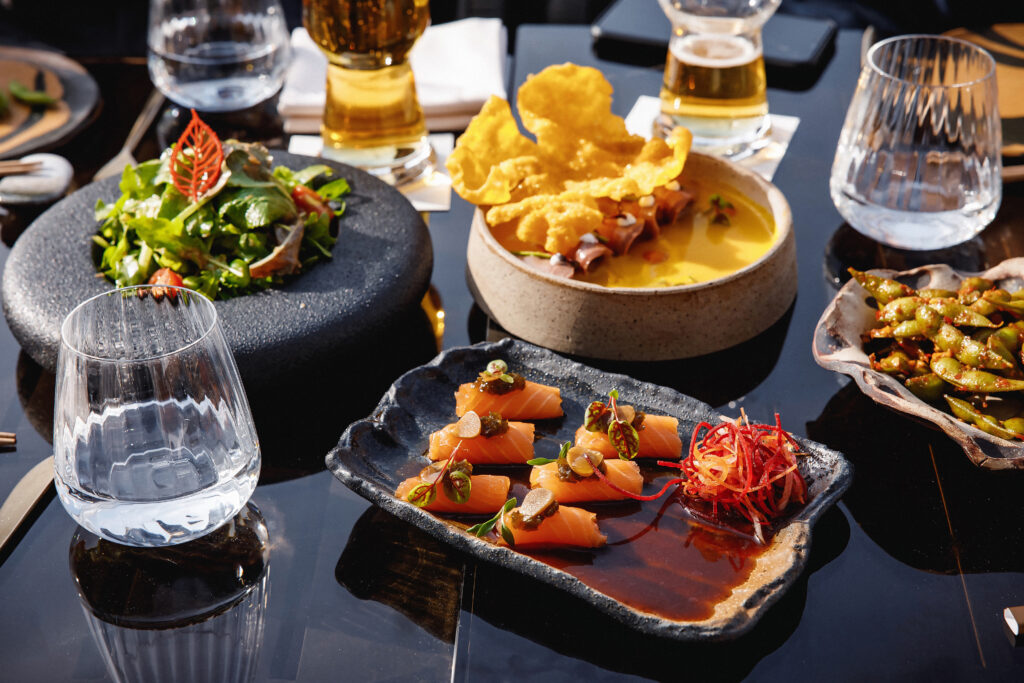
Originally referring to people of Japanese descent who were immigrants residing overseas, the term “Nikkei” is now frequently used to refer to a particular type of food. Nikkei cuisine is a delicious blend of Japanese and Peruvian ingredients that came about around the turn of the century and has influenced cooks all over the world. This article provides a brief overview of the history of Nikkei, where to find Nikkei food in Dubai, and its potential going forward.
How did Nikkei Cuisine Come to Existence?
Japanese immigrants first arrived in Peru with the intention of working in the sugar fields. Their story is one of struggle, hardship, and triumph. Despite having to work hard in a foreign country, the Japanese immigrants had become well-established in Peruvian culture by the time their children reached adulthood. Japanese immigrants to Peru quickly bought up small businesses, including shops, hair salons, and restaurants, of course. Authentic Nikkei food is now available everywhere including restaurant Dubai Burj Khalifa.
Introducing Seafood
One of the main ways that the Japanese influenced Nikkei Peruvian food was by introducing seafood into the diet. Before the Japanese arrived, most Peruvians did not eat seafood on a regular basis. Fish was the menu item if nothing else was available.
Seafood has been an integral part of Japanese cuisine and a staple of the Japanese diet for many generations. The immigrants to Peru took advantage of this essentially untapped wealth of marine resources, often eating raw seafood just as they would have in their native country.
Peruvian ingredients such as potatoes, lime, corn, chile, and cassava created the foundation of Nikkei. Experts observe that the cuisines of these two cultures complement each other well. It seems like a perfect match, the savory blend of soy and chili. What began as a necessity during a difficult time in history has now extended throughout the entire world.
Some Authentic Peruvian Dishes
Ceviche
Ceviche is the national dish of Peru. Anyone who gives it a try instantly falls in love with it. With just five simple ingredients—sea bass (corvina) marinated for a few minutes in lime juice, onion, salt, and—of course—hot chiles (aji)—Peru initiated this trend of serving cold-“cooked” fish. Other countries might be able to claim their own variants using tostada chips, tomatoes, octopus, scallops, and shrimp. Crisp onion brings out the softness of the super-fresh fish, and the starchy boiled corn (choclo) and creamy sweet potato (camote) balance out the texture of the dish. Add a handful of dry-roasted maize kernels (cancha) for a pleasant crunch.
Lomo Saltado (Stir-Fried Beef)
Almost as well-known as ceviche, this dish, called chifa, combines classic Peruvian ingredients with Chinese stir-frying. In a stir-fried pan with juicy strips of soy-marinated beef (or alpaca), add the onions, tomatoes, aji chiles, and other spices. Simmer until the beef is just cooked through and the tomatoes and onions start to form a rich, meaty gravy. Next, it’s topped with two starches, a delicious mixture of East and West, and an assortment of rice and french fries (which are occasionally combined with the meat). This is a highly popular dish in Peruvian restaurants abroad and is available practically anywhere in the country.
Aji de Gallina (Creamy Chicken)
Shredded chicken is topped with a creamy sauce made with cream, cheese, aji amarillo, and ground walnuts. The nutty, creamy sauce has a pungent but mild taste that balances the spice of the aji, giving it a pleasant warmth. This dish reflects the fondness that Peruvians have for thick sauces, which are typically made with meats and vegetables and enhanced by the addition of cheese, cream, chilies, or even bread. Here, the chicken and sauce are blended and served over rice with cooked potatoes and black olives, producing a vivid yellow chowder that shimmers on the dishes of Peruvian eateries and homes alike.
Causa (Potato Casserole)
Numerous European-style variations of this well-known Quechan meal are available; it is occasionally served as a cake roll, terrine, casserole, or in vibrant individual servings. Whatever the appearance, it all starts with a mixture of hearty mashed yellow Peruvian potatoes, oil, and spicy aji amarillo sauce. Shredded chicken, salmon, or tuna is mixed with mayo. On top are layers of avocado, hardboiled eggs, and olives. Spread more potato mixture over that surface again, and so forth, to make as many lasagna-like layers as one is brave enough to attempt. This bright, gently spicy meal can be served cold as a starter or a side dish.
The Future Of Nikkei Cuisine
Oftentimes, experimentation inspires creativity and innovation. For a long time, Nikkei food has been proof of this. Nikkei cuisine has survived as a global community and as a means of survival. After years of obscurity, it is gradually gaining international recognition due to dedicated chefs who are advancing the cause of the dish. Nikkei cuisine has a long history, but its cultural value is just now starting to be recognized internationally. It’s hard to predict how far it will grow and how future artists will interpret this rich cultural history.
Taste the Best Nikkei Cuisine at Nazcaa
Situated in the heart of Dubai, Nazcaa, a Nikkei cuisine restaurant in Dubai, is a great place to have amazing Nikkei food if you’re in Dubai. The Nazca civilization’s inventiveness and creativity had an influence on the restaurant’s founders, who combined Japanese and Peruvian cuisines. Savor delicious food and inventive beverages as you enjoy the Burj Khalifa skyline.